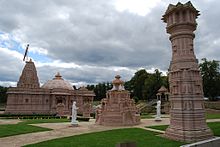The Jains in India are the last direct representatives of the ancient Shramana tradition. People who practice Jainism, an ancient religion of the Indian subcontinent, are collectively referred to as Jains.

Adherents of Jainism first arrived in the United States in the 20th century. Jain immigration began in earnest in the late 1960s and continues to the present day.
The Gujarati people, or Gujaratis, are an Indo-Aryan ethnolinguistic group who reside in or can trace their ancestry or heritage to a region of the Indian subcontinent primarily centered in the present-day western Indian state of Gujarat. They primarily speak Gujarati, an Indo-Aryan language. While Gujaratis mainly inhabit Gujarat, they have a diaspora worldwide. Gujaratis in India and the diaspora are prominent entrepreneurs and industrialists and maintain high social capital. Many notable independence activists were Gujarati, including Mahatma Gandhi and Vallabhbhai Patel.

The credit for introducing Jainism to the West goes to a German scholar, Hermann Jacobi, who translated some Jain literature and published it in the series 'Sacred Books of East' in 1884. In Europe, the largest Jain populations are in Britain, with a population of about 25,000.

Hinduism in England is the third largest religion in the country, with over 1,020,533 followers as of the 2021 Census. This represents over 1.5% of the English population, up from 1.1% the previous decade. Hindus are predominantly in the cities of London and Leicester, where they make up greater proportions of the population. England has a number of Hindu temples, including the Hindu temple at Neasden which is the largest Hindu temple in Europe. Recently the largest Hindu Mandir in the North of England, the Bradford Lakshmi Narayan Hindu Temple opened in Bradford, West Yorkshire.

Mahudi is a town in Mansa taluka of Gandhinagar district, Gujarat, India situated on the banks of Madhumati river, a tributary of Sabarmati River. It is a pilgrimage centre of Jains and other communities visiting temple of Jain deity, Ghantakarna Mahavir and Padmaprabhu Jain Temple. It was known as Madhupuri formerly.

Ghantakarna Mahavira is one of the fifty-two viras of Svetambara Jainism. He is chiefly associated with Tapa Gaccha, a monastic lineage. He was a deity of the Jain tantrik tradition. There is a shrine dedicated to him at the Mahudi Jain Temple established by Buddhisagar Suri, a Jain monk, in nineteenth century. It is one of the popular Jain pilgrimage centres of India.

Jain Canadians number 8,275, composing 0.02% of Canada's population. Adherents of Jainism first settled in Canada in small numbers in the late 19th century. The number of Jains in Canada later increased, leading to the establishment of Jain temples in Canada. The type of Jainism in Canada later exhibited several differences from Jainism in India.

The Jains in Belgium are estimated to be around about 1,500 people.

Jina Kanchi Jain Math, Melsithamur, is a Jain Matha that is located near Gingee, Villupuram district, Tamil Nadu, India.

Laxmisena, or Lakshmisena, is the name given to the head (Bhattaraka) of the Mel Sithamur Jain Math.

Chitrabhanu was a prominent figure in American Jainism. He was one of the co-founders of JAINA.

Vishwa Jain Sangathan (VJS) is a religious and social service organization of Jains in India. Amongst other things, it was involved in the Jain minority campaign.

Dakshin Bharat Jain Sabha (DBJS), also known as the South Indian Jain Association, is a religious and social service organization of the Jains in India. The organization is headquartered at Kolhapur, Maharashtra, India. The association is credited with being one of the first Jain associations to start reform movements among the Jains in modern India. The organization mainly seeks to represent the interests of the native Jains of Maharashtra, Karnataka and Goa.
Sompura Salat are a Hindu Vishwakarma Brahmin community of Gujarat, which have branched off from Sompura Brahmin community. They are also found in southern Rajasthan, specially in the Mewar region. Their origin is said to be from Prabhas Patan famous for the Somnath temple. The term "salat" is derived from Shilavat, the old term for a temple architect.
The history of Jainism in Australia is relatively short when compared to the history of Christianity on the same continent. There are four Jain centres in Australia. The Jain population in Australia was counted in the 2016 census to be 4,047, of whom 38% lived in Greater Sydney, 31% in Greater Melbourne, and 15% in Greater Perth. The states and territories with the highest proportion of Jains are Western Australia (0.025%) and Victoria (0.022%), whereas those with the lowest are Queensland (0.006%) and Tasmania (0.001%).
There are references in Jain texts to various areas of Southeast Asia. During the reign of Samprati, Jain teachers were sent to various Southeast Asian countries.

Mahudi Jain Temple is situated in Mahudi town in Mansa taluka of Gandhinagar district, Gujarat. It is a pilgrimage centre of Jains and other communities visiting the temple of Jain deity, Ghantakarna Mahavir and the Padmaprabhu Jain Temple. It was known as Madhupuri historically.













